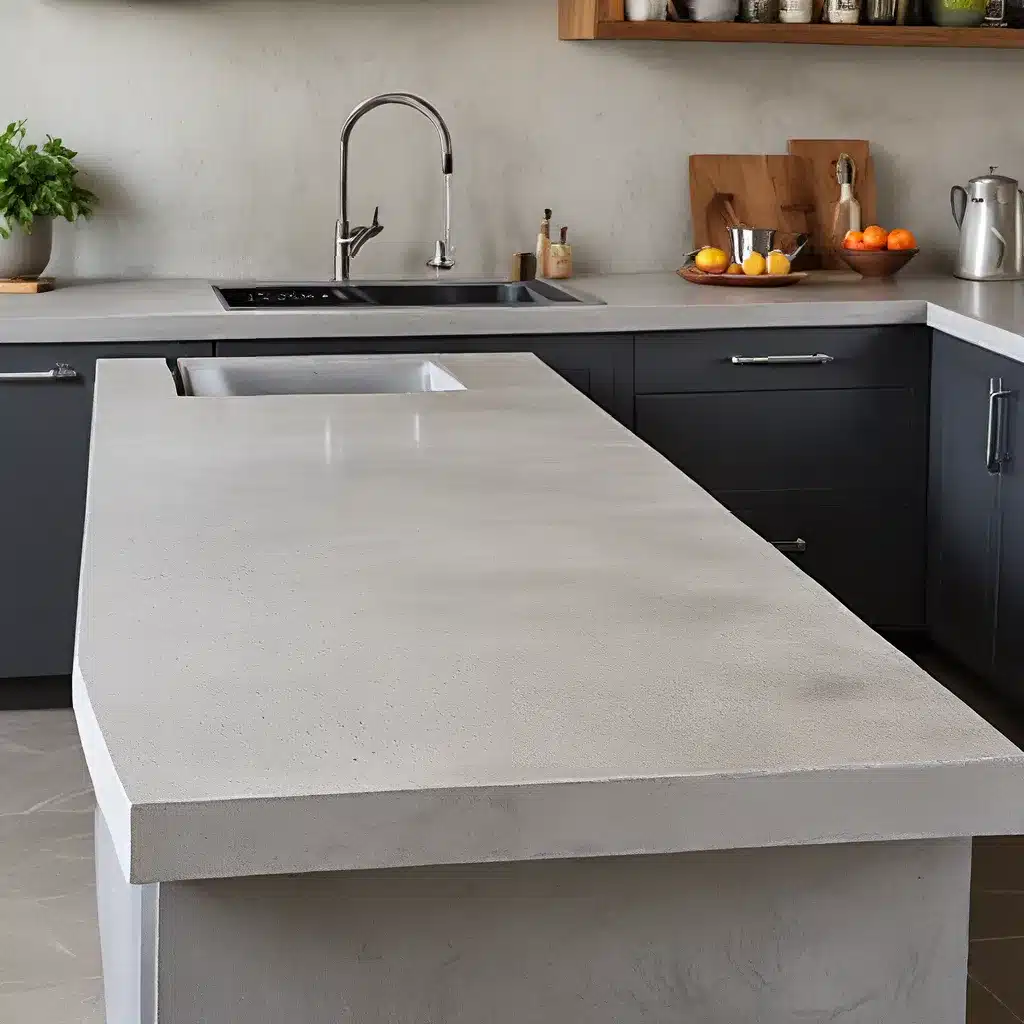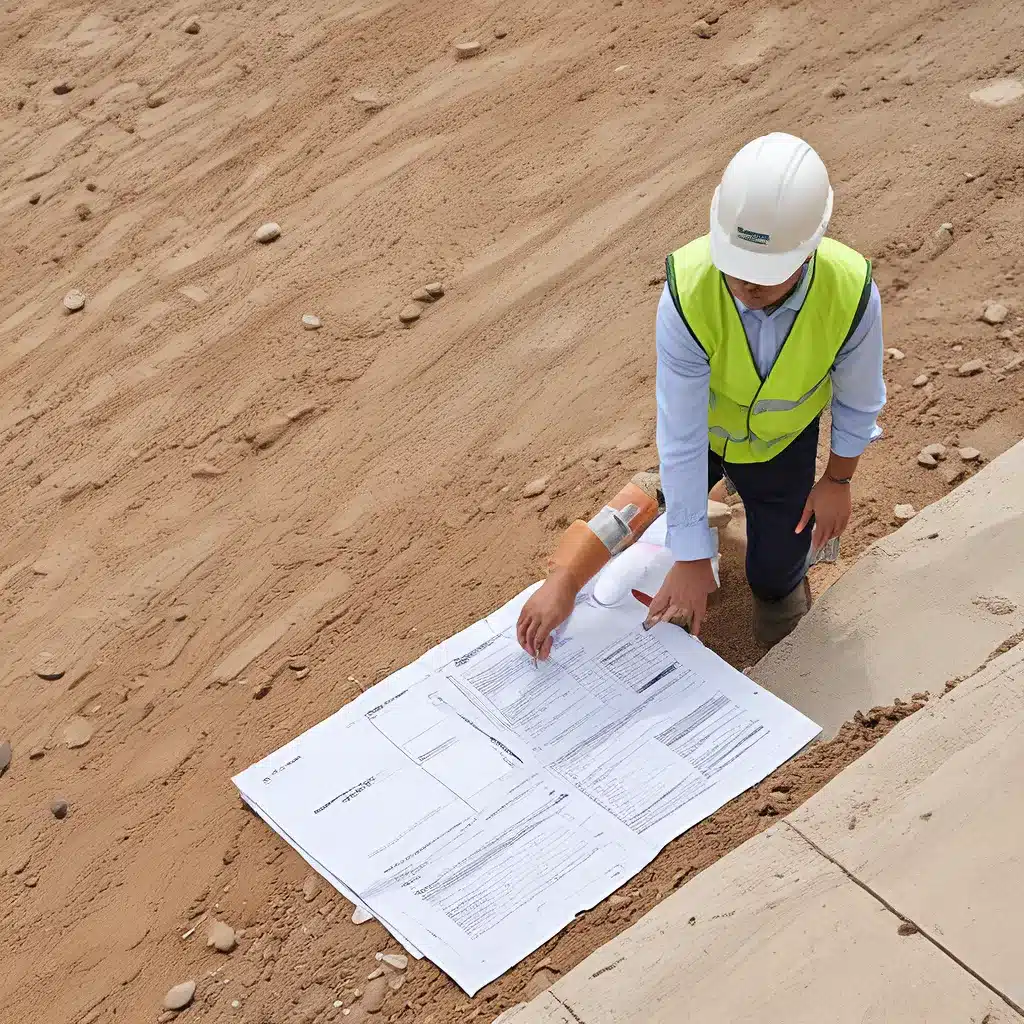
Concrete Countertops: The Unexpectedly Versatile Workhorse of the Kitchen
I’ll admit it – when I first heard about concrete countertops, I was a bit skeptical. “Concrete? In my kitchen? Isn’t that a bit… industrial?” I thought to myself. But as I started to dig deeper into this unique material, I realized that concrete countertops are so much more than just a utilitarian choice. In fact, with the right techniques and a bit of creativity, you can transform this seemingly humble material into a stunning, one-of-a-kind centerpiece for your kitchen.
Believe it or not, concrete countertops have been a growing trend in home design for the past decade or so. Homeowners and contractors alike have been drawn to the material’s durability, customizability, and unique, modern aesthetic. And the best part? With a little elbow grease and the right know-how, you can tackle the project of creating your own concrete countertops right at home.
The Beauty of Bespoke: Customizing Concrete Countertops
One of the things that makes concrete countertops so appealing is the sheer level of customization they offer. Unlike prefabricated stone or quartz options, concrete countertops can be molded, colored, and textured to your heart’s content.
Want to create a sleek, minimalist look with a smooth, polished finish? No problem. Prefer the rustic, handcrafted vibe of a lightly sandblasted surface? Easily done. Dreaming of vibrant, eye-catching hues to complement your kitchen’s color scheme? The sky’s the limit when it comes to concrete.
The process of making your own concrete countertops at home is certainly more involved than simply installing a prefab slab, but the payoff is well worth it. Not only will you end up with a truly unique, custom-fitted piece, but you’ll also have the satisfaction of knowing you created it yourself. And trust me, your friends and family will be seriously impressed when you casually mention that you made your countertops from scratch.
Concrete 101: Understanding the Basics
Before we dive into the nitty-gritty of the DIY concrete countertop process, let’s take a moment to cover the fundamentals. What exactly is concrete, and why is it such a popular choice for kitchen countertops?
Concrete is a composite material made up of cement, aggregates (such as sand and gravel), and water. When these ingredients are combined and allowed to harden, they form a durable, stone-like surface that is incredibly strong and resistant to wear and tear. This makes concrete an ideal choice for high-traffic areas like kitchen countertops, where it needs to withstand everything from heavy appliances to hot pots and pans.
But the real beauty of concrete lies in its versatility. Unlike natural stone, which is limited to the patterns and colors found in nature, concrete can be customized to your exact specifications. You can add pigments to create vibrant hues, embed decorative elements like glass or metal, and even play with textures to achieve a wide range of aesthetic effects.
And while concrete may seem like a heavy, industrial material, modern concrete countertop mixes are actually quite lightweight, making them a feasible DIY project for most homeowners. With the right tools and techniques, you can transform this humble material into a stunning, long-lasting surface that will be the envy of all your friends.
Getting Started: Preparing Your Workspace and Gathering Supplies
Alright, now that we’ve covered the basics, it’s time to dive into the hands-on part of creating your own concrete countertops. Before you can start mixing and pouring, you’ll need to set up a dedicated workspace and gather all the necessary supplies.
First things first: Choose a suitable location. Ideally, you’ll want to work in a well-ventilated area with a flat, level surface, such as a garage or basement. Concrete can be messy, so you’ll also want to protect the surrounding surfaces with drop cloths or plastic sheeting.
Next, assemble your toolkit. In addition to the obvious ingredients like cement, sand, and water, you’ll need a few specialized tools to make the process go smoothly. This includes things like a concrete mixer (or a sturdy mixing bucket and spoon), a mold or frame to shape the countertop, and various finishing tools like trowels, scrapers, and polishing pads.
Don’t forget the safety gear! Concrete work can be dusty and physically demanding, so make sure you have a pair of gloves, safety glasses, and a dust mask or respirator on hand.
With your workspace and supplies ready to go, you’re well on your way to crafting your very own custom concrete countertops. Just take a deep breath, and let’s get started!
Mixing and Pouring: The Heart of the Concrete Countertop Process
Alright, now for the fun part – it’s time to get your hands dirty and start mixing up your concrete! This is where the real magic happens, as you transform a simple blend of cement, aggregates, and water into a sturdy, customizable surface.
The first step is to create your concrete mix. There are a variety of pre-made mixes available on the market, but for a truly custom project, you’ll want to start from scratch. The basic formula is typically a 1:2:3 ratio of cement, sand, and gravel or crushed stone. You can also add in pigments, fiber reinforcements, or other specialty additives to achieve the exact look and performance you’re after.
Once your mix is ready, it’s time to pour. Carefully transfer the concrete into your prepared mold or frame, using a trowel or vibrating tool to ensure an even, bubble-free surface. And don’t be afraid to get a little creative! You can experiment with different textures and patterns by incorporating stamped designs, embedded objects, or even a hand-troweled finish.
After the concrete has had a chance to set and cure (typically 24-48 hours), it’s time to remove the mold and start the finishing process. This may involve sanding, polishing, or sealing the surface to achieve your desired look and level of durability.
The attention to detail in this stage is key. Take your time, work methodically, and don’t be afraid to make adjustments or start over if something doesn’t turn out quite right. Remember, you’re creating a one-of-a-kind piece, so the journey is just as important as the final result.
Finishing Touches: Polishing, Sealing, and Caring for Your Concrete Countertops
Alright, now that you’ve successfully mixed, poured, and cured your concrete countertops, it’s time to put the finishing touches on your masterpiece. This is where you’ll really be able to showcase the unique personality and style of your handiwork.
First up: polishing. Depending on the look you’re going for, you may want to leave your concrete with a more natural, matte finish, or you can opt for a high-gloss, mirror-like sheen. This is where your collection of sanding pads, polishing tools, and elbow grease will come in handy. Start with a coarse grit and gradually work your way up to a finer finish, taking care to smooth out any imperfections or uneven areas.
Next, it’s time to seal your countertops. Concrete is a porous material, which means it’s susceptible to staining and water damage if left unprotected. Fortunately, there are a variety of high-quality sealants on the market that can help safeguard your investment. Look for a clear, food-safe sealer that will enhance the natural beauty of the concrete without altering the color or texture too dramatically.
And don’t forget about ongoing maintenance! Concrete countertops may be durable, but they still require a bit of TLC to keep them looking their best. Be sure to wipe up spills promptly, use cutting boards to protect the surface, and reapply the sealer every few years as needed. With a little bit of care and attention, your custom concrete countertops will continue to be the envy of all your guests for years to come.
Bringing It All Together: Designing a Cohesive, Concrete-Centric Kitchen
Now that you’ve mastered the art of crafting your own concrete countertops, it’s time to start thinking about how they’ll fit into the bigger picture of your kitchen design. After all, these stunning surfaces deserve to be the star of the show, not just an afterthought.
One of the best ways to accentuate the beauty of your concrete countertops is to incorporate complementary materials and finishes throughout the rest of the space. Think about pairing them with natural wood cabinetry, brushed metal hardware, and even a concrete or tile backsplash for a cohesive, modern look.
And don’t be afraid to let your concrete countertops take center stage! Use them as a jumping-off point for your kitchen’s color scheme, drawing out the unique hues and textures in the material. Whether it’s a bold, earthy tone or a more subtle, muted palette, the possibilities are endless.
Finally, consider how you can use the inherent versatility of concrete to your advantage. Extend the countertops up the wall to create a seamless, waterfall edge, or incorporate custom-made concrete details like built-in planters or shelving units. The more you can integrate this material throughout your kitchen, the more cohesive and visually striking the overall design will be.
With a little bit of planning and creativity, your DIY concrete countertops can transform your kitchen into a truly one-of-a-kind oasis. So get ready to unleash your inner designer and start crafting the kitchen of your dreams!
Conclusion: Embrace the Beauty of Bespoke Concrete Countertops
Well, there you have it – everything you need to know to master the art of DIY concrete countertops. From mixing the perfect custom blend to polishing and sealing the final product, you’re now equipped with the knowledge and skills to transform this humble material into a stunning, personalized centerpiece for your kitchen.
Remember, the beauty of concrete lies in its sheer versatility. Whether you’re going for a sleek, modern look or a more rustic, handcrafted vibe, the possibilities are endless. So don’t be afraid to get creative, experiment with different techniques and finishes, and put your own unique stamp on the process.
And who knows – by the time you’re done, you might just find yourself with a newfound appreciation for the humble concrete countertop. What was once just a utilitarian surface has now been elevated to a true work of art, a reflection of your personal style and design sensibilities.
So why settle for a generic, off-the-shelf countertop when you can craft something truly special? With a little elbow grease and a whole lot of creativity, your dream kitchen is just waiting to be built.
Happy DIYing, my friends! I can’t wait to see what kind of concrete masterpieces you come up with.
Related posts:
No related posts.




